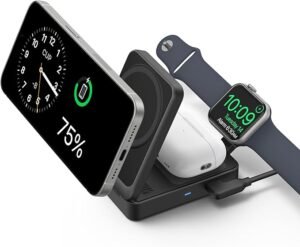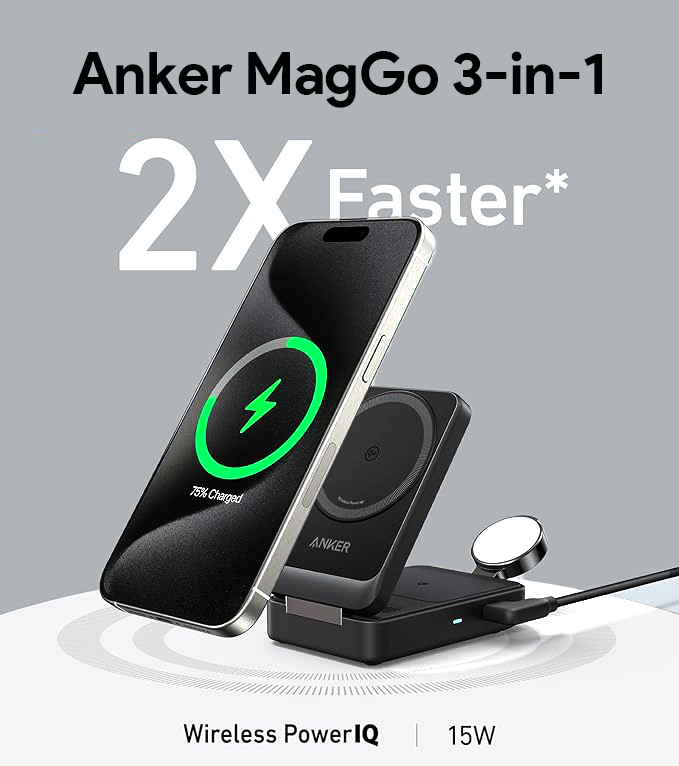My Experience Switching to a Qi2 Wireless Charger
“Wait, the iPhone 16 Pro supports 25W wireless charging? That’s the same as wired charging speed!”
This was the most surprising revelation I discovered in recent iPhone 16 Pro reviews.
But then I wondered—doesn’t the Galaxy S25 also support Qi2, enabling 15W charging? That speed isn’t negligible. So, wouldn’t it be worth testing a compatible charger myself?
With that in mind, I purchased a Qi2 charger and a MagSafe-compatible case to share my experience. Finally, my MagSafe debut!
MagSafe: Apple’s Revolutionary Magnetic Standard
The now-ubiquitous MagSafe standard was developed by Apple and has been supported since the iPhone 12.
Simply put, it involves magnets embedded in the back of smartphones, allowing accessories like card wallets, phone stands, and portable batteries to attach seamlessly.
Initially, I thought, “What’s the big deal?” But now, MagSafe-compatible products are everywhere—even Android phones have started adopting it.
Once again, Apple has led the way in practical innovation. The company doesn’t just focus on design; it pushes functionality to new heights.
MagSafe: Apple’s Clever New Revenue Stream
To sell MagSafe products officially, manufacturers must pay Apple a licensing fee. This has become a new revenue source, replacing the Lightning port ecosystem. Genius business strategy.
Qi2: The Latest Wireless Charging Standard (15W + Magnets)
Separate from MagSafe, wireless charging standards have also evolved—the newest being “Qi2.”
Key features:
- Magnets are mandatory for precise alignment
- Charging speed is standardized at 15W
- Unlike Qi1 (which ranged from 5W to 15W), Qi2 ensures faster, more reliable charging with fewer failures
| Specification | Qi2 | Qi1 | MagSafe |
|---|---|---|---|
| Magnets | Yes | No | Yes |
| Maximum Power | 15W | 5W–15W | 25W |
15W charging isn’t blazing fast, but it’s certainly not slow either. Considering wired charging typically delivers 25W, 15W is more than sufficient for daily wireless use.
Note: Currently, only the iPhone 16 series (excluding the iPhone 16e) supports 25W wireless charging—and only with Apple-certified chargers.
Step One: Getting a MagSafe-Compatible Case
My current main phone is the Galaxy S25, which officially supports Qi2 charging.
However, I heard the Galaxy S25’s magnetic force is relatively weak, making MagSafe less reliable. (Update: The S25 might only support 15W charging without built-in magnets.)
So, I first purchased a case with built-in MagSafe magnets.
Many brands now sell MagSafe cases for Android, making it easy to adopt the feature. Convenience at its finest.
![Spigen Ultra Hybrid MagFit Designed for Galaxy S25 Case [Qi2 Certified/Magnet for Galaxy] (2025) - Clear White](https://dailyedge.net/wp-content/uploads/2025/05/71TUPGeCpaL._AC_SX679_-150x150.jpg) | Spigen Ultra Hybrid MagFit Designed for Galaxy S25 Case [Qi2 Certified/Magnet for Galaxy] (2025) – Clear White Buy on Amazon |
Step Two: Purchasing a Qi2 Wireless Charger
With the Galaxy S25 ready, all I needed was a Qi2 charger.
I was surprised by the pricing—still relatively high due to the new standard. Most options on Amazon were over $90.
Fortunately, I found the “Anker MagGo 3in1” Qi2 charger for under $89.99 after applying available coupons.
Charger features:
- Stand design when placed vertically
- Wireless earbuds charging pad at the base + Apple Watch charger on the back
- Foldable and compact (6.9oz), great for travel
- Strong magnets on top—iPhone 16 Pro sticks securely even without a case
- Galaxy S25 also locks in place perfectly with a MagSafe case
 | Anker MagGo 3-in-1 MagSafe-Compatible Wireless Charger Stand, Qi2 Certified 15W Foldable Charger (40W USB-C Charger Included) Buy on Amazon |
Real-World Qi2 Charging Speed: 12W (Impressively Practical)
The big question: Does it really deliver the promised 15W?
My testing showed approximately 12W—slightly below the advertised 15W, but still quite good. (Even wired “25W” charging usually maxes out at around 23W in real-world use.)
That’s roughly 52% of wired charging speed, which is perfectly practical for everyday use. Using the MagSafe charger as a phone stand makes charging effortless—it happens in the background while you work or relax.
Placing it next to my monitor added a nice tech-enthusiast vibe to my workspace. Though cable management remains a challenge—I’m still figuring out how to keep everything tidy.
When charging earbuds simultaneously, the total output reached 15W (12W for phone + 3W for earbuds).
Qi2 Charging Is More Practical Than Expected
Older wireless charging was unstable and only practical for overnight charging. But Qi2’s magnetic alignment combined with standardized 15W output makes it genuinely convenient for daily use.
Even for devices like the Galaxy S25 (Qi2-compatible but with weaker built-in magnets), this is likely just a transitional issue. As Qi2 adoption spreads, usability will only improve across the ecosystem.
The 15W charging speed is practical enough for most situations, and the magnetic alignment is a genuine game-changer for the wireless charging experience.
Strategically placing Qi2 chargers around your home or office can significantly boost convenience in your daily tech routine.
Conclusion
Huge credit to Apple for pioneering this magnetic wireless charging standard—and to Android manufacturers for embracing it. Market competition truly drives innovation!
The era of next-generation wireless charging is finally here, and it’s more practical than ever before.

